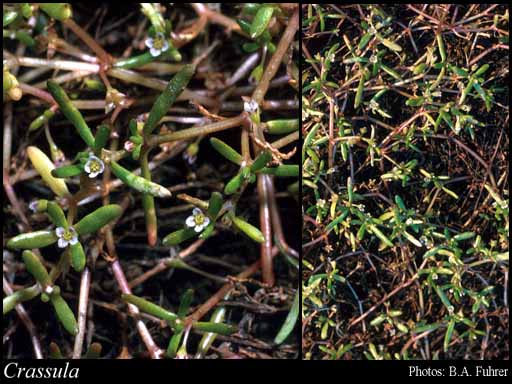- Reference
- Sp.Pl. 2:282 (1753)
- Name Status
- Current

Scientific Description
Family Crassulaceae.
Habit and leaf form. Herbs, or shrubs; evergreen. Plants succulent. Herbs annual, or perennial; plants with a basal concentration of leaves, or with neither basal nor terminal concentrations of leaves. Xerophytic, or mesophytic, or hydrophytic; rooted. Leaves opposite; fleshy; petiolate, or sessile; connate (at the nodes), or not connate; simple; not peltate. Leaf blades entire; flat (more or less), or solid; one-veined, or pinnately veined; cross-venulate, or without cross-venules. Leaves without stipules. Leaf blade margins entire. Leaves without a persistent basal meristem. Leaf anatomy. Hydathodes present. Stem anatomy. Nodes unilacunar, or tri-lacunar. Secondary thickening developing from a conventional cambial ring.
Reproductive type, pollination. Fertile flowers hermaphrodite. Unisexual flowers absent. Plants hermaphrodite. Floral nectaries present. Nectar secretion seemingly from the gynoecium (each carpel with a nectariferous scale-like appendage abaxially near the base). Entomophilous.
Inflorescence and flower features. Flowers aggregated in ‘inflorescences’, or solitary (rarely); in cymes, or in panicles (a thyrse, with several, rarely only 1 dichasium, or reduced to a monochasium). The terminal inflorescence unit cymose. Flowers minute to small; regular, or somewhat irregular (often sepals unequally long). The floral asymmetry when irregular, involving the perianth. Flowers 3–5 merous (usually partly hidden by leaf-like bracts, sometimes situated in the axil of one pair of leaf-like bracts in a monochasium); cyclic; pentacyclic. Floral receptacle not markedly hollowed. Free hypanthium present, or absent. Hypogynous disk seemingly absent (i.e. the nectariferous appendages being interpreted as gynoecial). Perianth with distinct calyx and corolla; 6–10; 2 -whorled; isomerous. Calyx 3–5; 1 -whorled; polysepalous, or gamosepalous (basally); imbricate; regular; fleshy; persistent. Corolla 3–5; 1 -whorled; polypetalous, or gamopetalous (basally); imbricate; lobes spreading or tubular, the apices more or less recurved; regular; white to cream, or yellow to red. Androecium 3–5. Androecial members adnate (episepalous, or in gamopetalous corollas affixed to the corolla tube); free of one another; 1 -whorled. Androecium exclusively of fertile stamens. Stamens 3–5. Staminal insertion near the base of the corolla tube. Stamens isomerous with the perianth; oppositisepalous. Filaments glabrous. Anthers more or less basifixed; non-versatile; dehiscing via longitudinal slits; introrse; bilocular; tetrasporangiate. Gynoecium 3–5 carpelled. Carpels isomerous with the perianth. Gynoecium apocarpous, or syncarpous; eu-apocarpous, or semicarpous (when the carpels slightly united at the base); superior. Carpel apically stigmatic; 1–20 ovuled. Placentation (sub) marginal. Stigmas wet type; papillate; Group III type. Ovules pendulous to horizontal; biseriate; non-arillate; anatropous.
Fruit and seed features. Fruit non-fleshy; an aggregate. The fruiting carpels not coalescing. The fruiting carpel dehiscent; a follicle. Seeds with usually indistinct vertical ridges or tubercles arranged in vertical lines; endospermic. Endosperm oily. Cotyledons 2. Embryo straight. Seedling. Germination phanerocotylar.
Physiology, biochemistry. Aluminium accumulation not found. Photosynthetic pathway: CAM.
Geography, cytology, number of species. Native of Australia. Not endemic to Australia. Australian states and territories: Western Australia, South Australia, Northern Territory, Queensland, New South Wales, Victoria, Australian Capital Territory, and Tasmania. South-West Botanical Province.
Taxonomic Literature
- Wheeler, Judy; Marchant, Neville; Lewington, Margaret; Graham, Lorraine 2002. Flora of the south west, Bunbury, Augusta, Denmark. Volume 2, dicotyledons. Australian Biological Resources Study.. Canberra..
- Grieve, B. J.; Blackall, W. E. 1998. How to know Western Australian wildflowers : a key to the flora of the extratropical regions of Western Australia. Part II, Dicotyledons (Amaranthaceae to Lythraceae). University of W.A. Press.. Nedlands, W.A..
- Toelken, H. R. 1981. The species of Crassula L. in Australia.